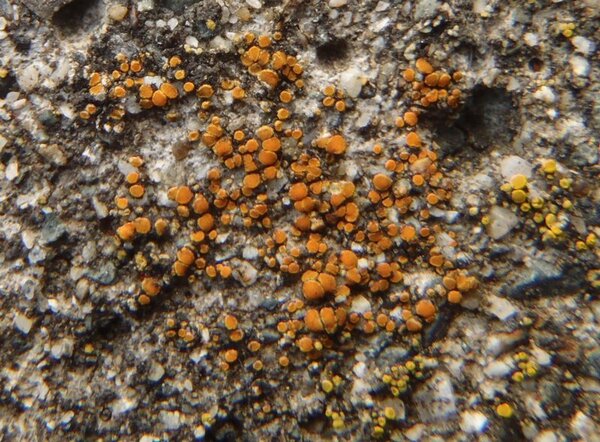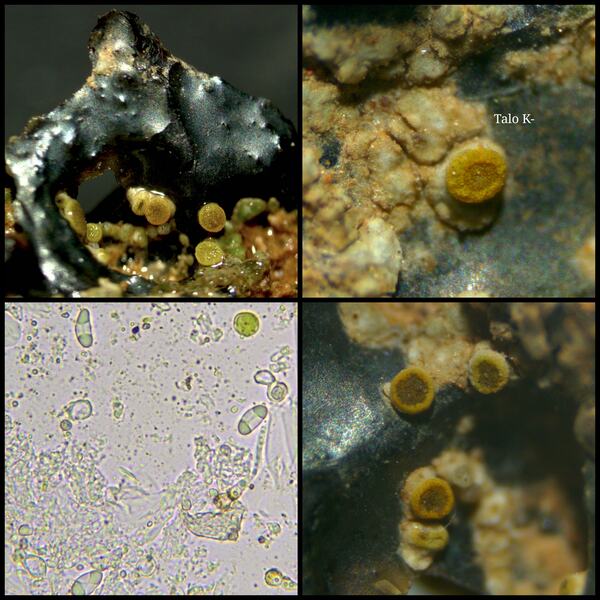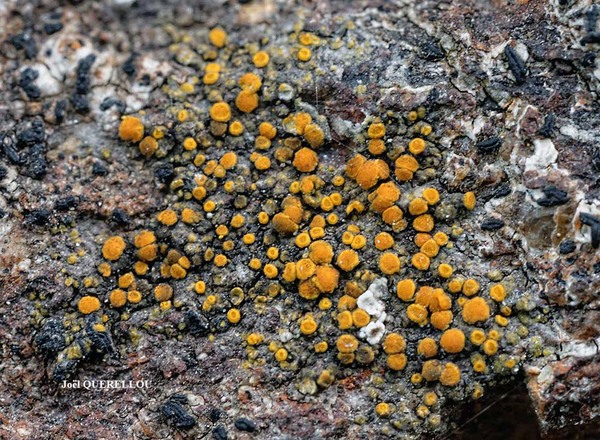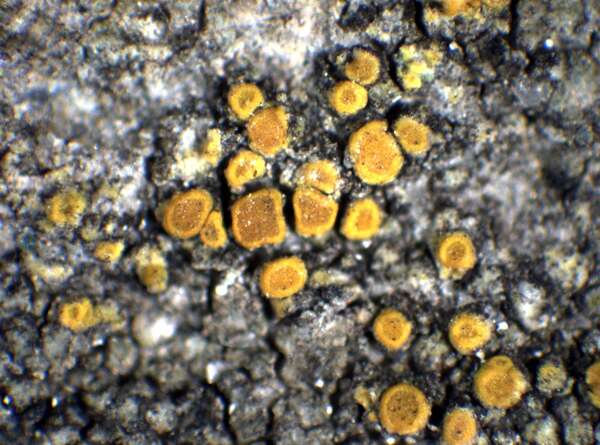Athallia holocarpa (Hoffm.) Arup, Frödén & Søchting
in Arup & al., Nord. J. Bot., 31: 36, 2013. Basionym: Verrucaria oblitterata var. holocarpa Hoffm. - Deutsch. Fl., 2, 179, 1796,
Synonyms: Athallia vitellinula ; Callopisma aurantiacum var. holocarpum (Ach.) A. Massal.; Caloplaca aurantiaca var. holocarpa (Ach.) Th. Fr.; Caloplaca holocarpa (Ach.) A.E. Wade; Caloplaca pyracea var. holocarpa (Ach.) Th. Fr.; Caloplaca vitellinula (Nyl.) H. Olivier; Lecanora vitellinula Nyl.; Placodium aurantiacum var. holocarpum (Ach.) Anzi; Placodium pyraceum var. holocarpum (Ach.) Anzi
Distribution: N - Ven, TAA (Nascimbene & al. 2022), VA, Lig (TSB 33408). C - Tosc (TSB 21532), Marc (TSB 24077), Abr. (Gheza & al. 2021), Mol (TSB32538), Sar (B-189907). S - Camp, Bas (TSB 29938), Si (Puglisi & Cataldo 2019).
Description: Thallus absent or developed only around apothecia, sometimes continuous, slightly cracked and verruculose; grey to grey-orange. Cortex usually poorly developed, composed of an amorphous layer or indistinctly paraplectenchymatous. Apothecia frequent, zeorine, 0.3-1(-l.2) mm across, with a flat to slightly convex, yellow-orange to orange disc and a concolorous or slightly paler proper margin, rarely with a poorly developed thalline margin in the basal part of young apothecia. Proper exciple 25-60(-75) µm wide, of irregularly radiating, thick-walled hyphae with rather long and narrow cells, measuring 5-15 x 1-3.5 µm; epithecium orange, granular, K+ purple-red, C-; hymenium colourless, (55-)65-80(-100) μm high, sometimes inspersed with oil droplets; paraphyses simple to sparingly branched in upper part, 2-2.5 μm thick at mid-level, the apical cells to 3-5 μm wide; hypothecium colourless, 50-80(-100) μm high, sometimes inspersed with oil droplets. Asci 8-spored, cylindrical, functionally unitunicate, apically thickened with a broad internal beak, the inner part of apex and external cap I+ blue, Teloschistes-type. Ascospores 2-celled, polarilocular, hyaline, ellipsoid to broadly ellipsoid, (9.5-)10-14(-15.5) x 5-8.5 μm, the equatorial thickening (“septum”) (3-)3.5-5(-5.8) μm, 1/3-1/2 of spore length. Photobiont chlorococcoid. Spot tests: thallus K- or K+ purple-red, C-, KC-, P-; apothecia K+ purple-red, C-. Chemistry: apothecia and orange-pigmented parts of thallus (when present) with parietin (major), fallacinal, emodin, teloschistin and parietinic acid (minor).Note: according to Arup (2009) this is a silicicolous, rarely lignicolous species of more or less eutrophicated habitats, mostly found on the top of isolated boulders. The epithet holocarpa, however, has been widely used for different lichens occurring both on bark and on calcareous rocks, which are mainly treated here under Athallia pyracea and Flavoplaca oasis f. lithophila. Due to the extreme confusion still concerning this group in Southern Europe, I place here only a few records from siliceous rocks which I could check in TSB. On the synonymisation of Athallia vitellinula see Vondrák & al. (2016).
Growth form: Crustose
Substrata: rocks
Photobiont: green algae other than Trentepohlia
Reproductive strategy: mainly sexual
Pioneer species
Commonnes-rarity: (info)
Alpine belt: rare
Subalpine belt: rather rare
Oromediterranean belt: rather rare
Montane belt: rather rare
Submediterranean belt: rather rare
Padanian area: rare
Humid submediterranean belt: rare
Humid mediterranean belt: rare
Dry mediterranean belt: rare

Predictive model
Herbarium samples
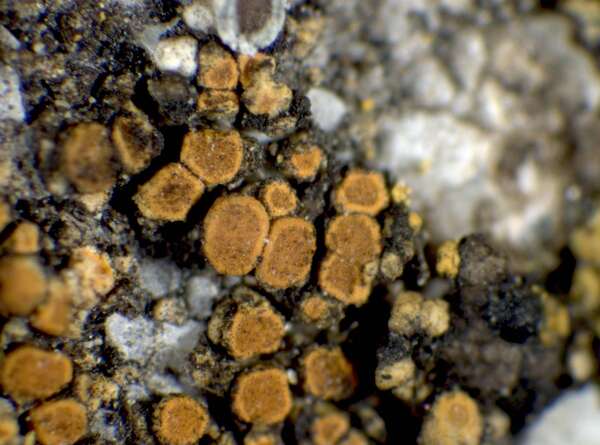

P.L. Nimis; Owner: Department of Life Sciences, University of Trieste
Herbarium: TSB (29938)
2001/12/03
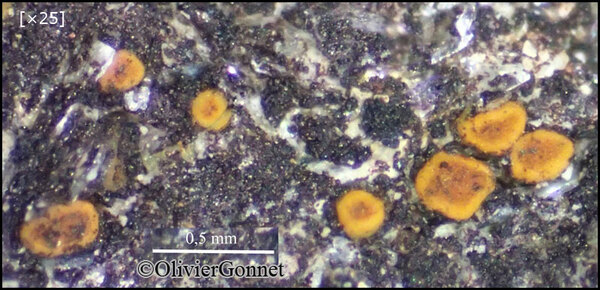
Courtesy Danièle et Olivier Gonnet - Source: https://www.afl-lichenologie.fr/Photos_AFL/Photos_AFL_A/Textes_A4/Athallia_holocarpa.htm
France, Près du cimetière, Saint-Prejet-Armandon - Haute-Loire
18/11/2015

Courtesy Danièle et Olivier Gonnet - Source: https://www.afl-lichenologie.fr/Photos_AFL/Photos_AFL_A/Textes_A4/Athallia_holocarpa.htm
France, Près du cimetière, Saint-Prejet-Armandon - Haute-Loire
18/11/2015
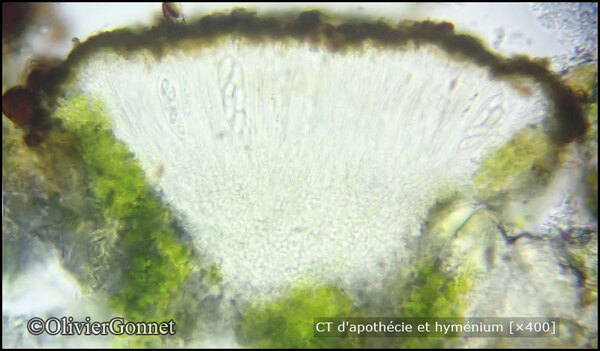
Courtesy Danièle et Olivier Gonnet - Source: https://www.afl-lichenologie.fr/Photos_AFL/Photos_AFL_A/Textes_A4/Athallia_holocarpa.htm
France, Près du cimetière, Saint-Prejet-Armandon - Haute-Loire
18/11/2015
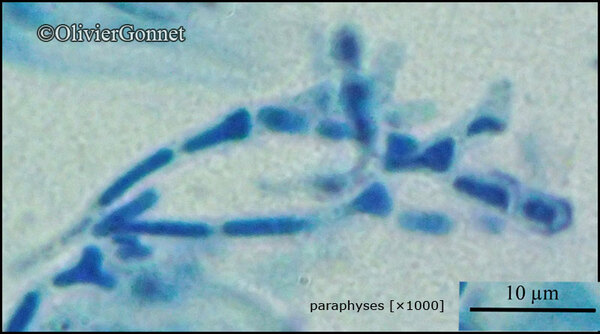
Courtesy Danièle et Olivier Gonnet - Source: https://www.afl-lichenologie.fr/Photos_AFL/Photos_AFL_A/Textes_A4/Athallia_holocarpa.htm
France, Près du cimetière, Saint-Prejet-Armandon - Haute-Loire
18/11/2015
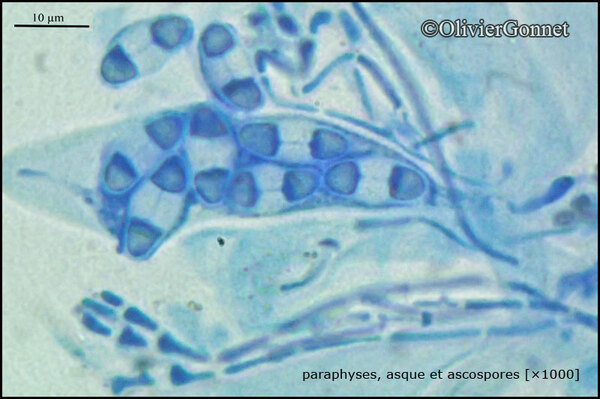
Courtesy Danièle et Olivier Gonnet - Source: https://www.afl-lichenologie.fr/Photos_AFL/Photos_AFL_A/Textes_A4/Athallia_holocarpa.htm
France, Près du cimetière, Saint-Prejet-Armandon - Haute-Loire
18/11/2015
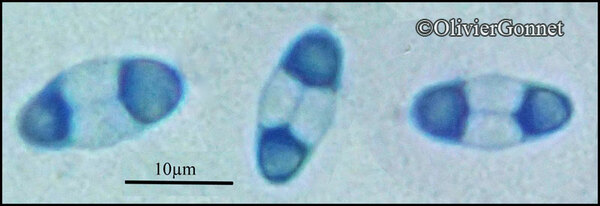
Courtesy Danièle et Olivier Gonnet - Source: https://www.afl-lichenologie.fr/Photos_AFL/Photos_AFL_A/Textes_A4/Athallia_holocarpa.htm
France, Près du cimetière, Saint-Prejet-Armandon - Haute-Loire
18/11/2015
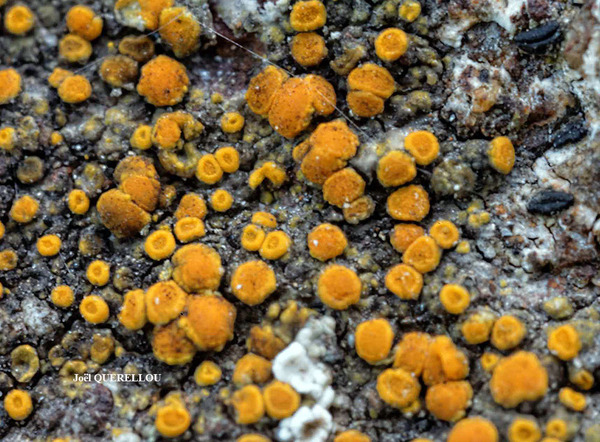
Joël Querellou - Source: http://www.lichensmaritimes.org/index.php?task=fiche&lichen=725&lang=en
Belgium, Brest, siliceous rock
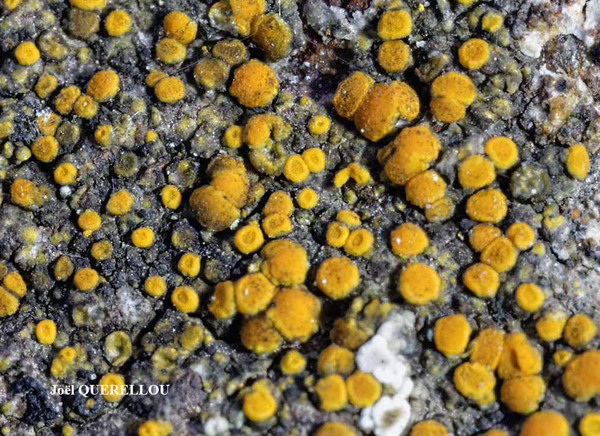
Joël Querellou - Source: http://www.lichensmaritimes.org/index.php?task=fiche&lichen=725&lang=en
Belgium, Brest, siliceous rock
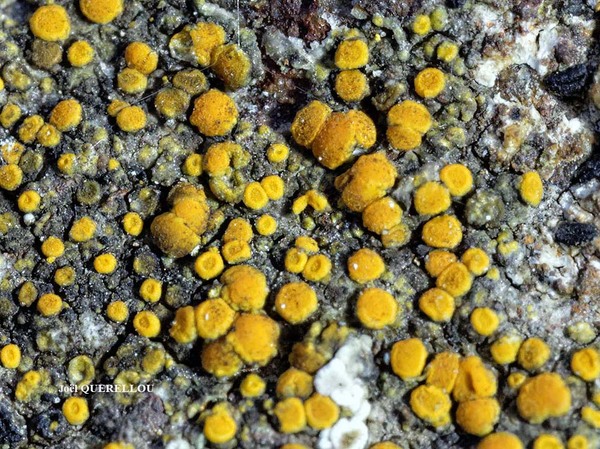
Joël Querellou - Source: http://www.lichensmaritimes.org/index.php?task=fiche&lichen=725&lang=en
Belgium, Brest, siliceous rock
Growth form: Crustose
Substrata: rocks
Photobiont: green algae other than Trentepohlia
Reproductive strategy: mainly sexual
Pioneer species
Commonnes-rarity: (info)
Alpine belt: rare
Subalpine belt: rather rare
Oromediterranean belt: rather rare
Montane belt: rather rare
Submediterranean belt: rather rare
Padanian area: rare
Humid submediterranean belt: rare
Humid mediterranean belt: rare
Dry mediterranean belt: rare

Predictive model
| Herbarium samples |


P.L. Nimis; Owner: Department of Life Sciences, University of Trieste
Herbarium: TSB (29938)
2001/12/03

Courtesy Danièle et Olivier Gonnet - Source: https://www.afl-lichenologie.fr/Photos_AFL/Photos_AFL_A/Textes_A4/Athallia_holocarpa.htm
France, Près du cimetière, Saint-Prejet-Armandon - Haute-Loire
18/11/2015

Courtesy Danièle et Olivier Gonnet - Source: https://www.afl-lichenologie.fr/Photos_AFL/Photos_AFL_A/Textes_A4/Athallia_holocarpa.htm
France, Près du cimetière, Saint-Prejet-Armandon - Haute-Loire
18/11/2015

Courtesy Danièle et Olivier Gonnet - Source: https://www.afl-lichenologie.fr/Photos_AFL/Photos_AFL_A/Textes_A4/Athallia_holocarpa.htm
France, Près du cimetière, Saint-Prejet-Armandon - Haute-Loire
18/11/2015

Courtesy Danièle et Olivier Gonnet - Source: https://www.afl-lichenologie.fr/Photos_AFL/Photos_AFL_A/Textes_A4/Athallia_holocarpa.htm
France, Près du cimetière, Saint-Prejet-Armandon - Haute-Loire
18/11/2015

Courtesy Danièle et Olivier Gonnet - Source: https://www.afl-lichenologie.fr/Photos_AFL/Photos_AFL_A/Textes_A4/Athallia_holocarpa.htm
France, Près du cimetière, Saint-Prejet-Armandon - Haute-Loire
18/11/2015

Courtesy Danièle et Olivier Gonnet - Source: https://www.afl-lichenologie.fr/Photos_AFL/Photos_AFL_A/Textes_A4/Athallia_holocarpa.htm
France, Près du cimetière, Saint-Prejet-Armandon - Haute-Loire
18/11/2015

Joël Querellou - Source: http://www.lichensmaritimes.org/index.php?task=fiche&lichen=725&lang=en
Belgium, Brest, siliceous rock

Joël Querellou - Source: http://www.lichensmaritimes.org/index.php?task=fiche&lichen=725&lang=en
Belgium, Brest, siliceous rock

 INDEX FUNGORUM
INDEX FUNGORUM
 GBIF
GBIF
 DOLICHENS
DOLICHENS
